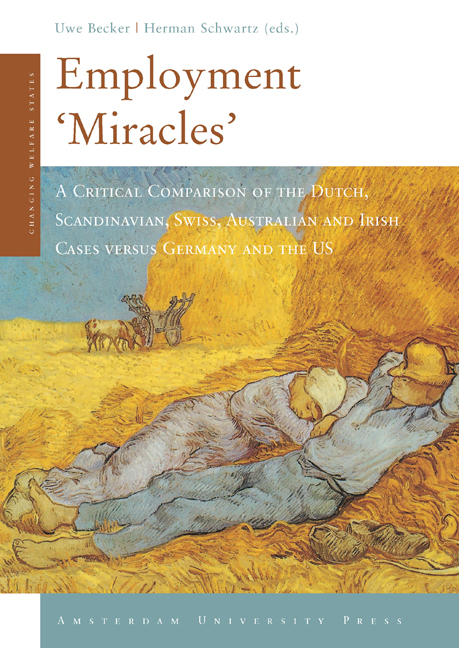 Employment 'Miracles'
Employment 'Miracles' Book contents
- Forntmatter
- Contents
- Preface
- 1 Introduction: Miracles, Mirages and Markets
- 2 The Dutch Model: Magic in a Flat Landscape?
- 3 Employment and Unemployment in Denmark and Sweden: Success or Failure for the Universal Welfare Model?
- 4 The Evolution of the Finnish Model in the 1990s: From Depression to High-Tech Boom
- 5 The Swiss Miracle: Low growth and high employment
- 6 Recasting the Story of Ireland’s Miracle: Policy, Politics or Profit?
- 7 The Australian Miracle: Luck, Pluck or Being Stuck Down Under?
- 8 Last Year’s Model? Reflections on the American Model of Employment Growth
- 9 The German Contrast. On Bad Comparisons, Special Circumstances, Luck and Policies That Turned Out to Be Wrong
- 10 Conclusion: The Importance of Lucky Circumstances, and Still the Liberal-Social Democratic Divide
- Bibliography
- Contributors
- Index
3 - Employment and Unemployment in Denmark and Sweden: Success or Failure for the Universal Welfare Model?
Published online by Cambridge University Press: 15 January 2021
- Forntmatter
- Contents
- Preface
- 1 Introduction: Miracles, Mirages and Markets
- 2 The Dutch Model: Magic in a Flat Landscape?
- 3 Employment and Unemployment in Denmark and Sweden: Success or Failure for the Universal Welfare Model?
- 4 The Evolution of the Finnish Model in the 1990s: From Depression to High-Tech Boom
- 5 The Swiss Miracle: Low growth and high employment
- 6 Recasting the Story of Ireland’s Miracle: Policy, Politics or Profit?
- 7 The Australian Miracle: Luck, Pluck or Being Stuck Down Under?
- 8 Last Year’s Model? Reflections on the American Model of Employment Growth
- 9 The German Contrast. On Bad Comparisons, Special Circumstances, Luck and Policies That Turned Out to Be Wrong
- 10 Conclusion: The Importance of Lucky Circumstances, and Still the Liberal-Social Democratic Divide
- Bibliography
- Contributors
- Index
Summary
Introduction
During the 1970s and 1980s, Sweden became a model country for foreign observers. At times when unemployment in many other countries reached a level of more than 10 percent, Sweden kept its unemployment at golden age levels. In the beginning of the 1990s, the Swedish model collapsed. Unemployment sky-rocketed to almost 10 percent, and foreign observers lost some of their interest in the Swedish model. Denmark has experienced a reverse development. In the 1980s, the country was plagued by high unemployment. However in the 1990s, Denmark became a new model country as unemployment decreased to around 5 percent. Today, a discussion of the Danish “miracle” is taking place (Schwartz 2001 b and c, Green-Pedersen 2001 and 2003, Hemerijck and Schludi 2000, and Becker 2001c).
This chapter provides a closer look at this stereotypical picture of the two countries. The focus of the chapter is on the development of unemployment and employment in the two countries. The miracle discussion also refers to other economic indicators such as public finances, growth, and inflation, but employment and unemployment have tended to attract the most attention (cf. Scharpf 2000). We aim to do two things. First, to provide a more detailed look at the development of unemployment and employment in the two countries. Upon a closer look, how positive or negative were the developments in the 1980s and the 1990s actually? And do they match the stereotypical picture sketched above? Second, we provide an overview of socioeconomic, especially labour market policy in the two countries. This includes both the historical content of these policies and the adjustment made to them in the 1990s. The aim of this second part is to search for possible explanations for the development of employment and unemployment. Explaining the actual development of unemployment and employment is difficult, but we provide some tentative conclusions.
A further reason for paying attention to the developments in the two countries is that they are both examples of a “social democratic” type of political economy (Scharpf and Schmidt 2000 and Huber and Stephens 2001a). This refers to a political economy with 1) a generous and “decommodifying” welfare state offering transfers and services based on citizenship, 2) a labour market with high levels of both public and female employment, 3) centralized wage-bargaining.
- Type
- Chapter
- Information
- Employment 'Miracles'A Critical Comparison of the Dutch, Scandinavian, Swiss, Australian and Irish Cases versus Germany and the US, pp. 65 - 86Publisher: Amsterdam University PressPrint publication year: 2005
- 1
- Cited by


